
Welcome to writer Phyllis Doyle Burn's second guest article on the Carolinian's Archives. This is first of three stories about Vikings by Phyllis, with the other two to be published over the next several months on Once Upon a History. An ambitious and exciting undertaking by our guest writer that is most welcome.
Phyllis has 144 charming and informative articles on the link below, covering such topics as history, folklore/mythology, spirituality, Native American culture, poetry and much more. She also happens to be one of the most friendly, sincere, informative and talented people I know.
Phyllis's marvelous site can be found by searching: phyllisdoyle @ HubPages
Phyllis has 144 charming and informative articles on the link below, covering such topics as history, folklore/mythology, spirituality, Native American culture, poetry and much more. She also happens to be one of the most friendly, sincere, informative and talented people I know.
Phyllis's marvelous site can be found by searching: phyllisdoyle @ HubPages
Viking Age, 793 to 1066 ~
The Viking Age is a very important element of medieval history of Scandinavia and Europe. With the expansion the Vikings accomplished in their seafaring journeys, it opened up a large portion of Great Britain, Ireland, France, Sicily, Russia and Europe in general.
Viking! In ancient times that word struck terror in the minds of people. The Viking Age was a time of great exploration for the seafaring Norse warriors. The legends and stories of the Viking Age and their rise and fall are incredible -- whether real life, myth or folklore, they can hold one spellbound.
"Na Lochlannaigh ag teacht!" (The Vikings are coming!), was an often heard warning in ancient Ireland during the days when these seafaring warriors were exploring the world, mapping new pathways in the seas, or on a raid.
In the early history of Europe, especially Northern Europe where the Scandinavian kingdoms of Denmark, Norway, and Sweden ruled, the Viking Age was the period between 793 and 1066. It was an era when the Scandinavian Norsemen expanded explorations by sea for trade, conquests, raids, and the expansion of settlements.
These Norse warriors were expert at navigating the seas. They were very knowledgeable of the stars and constellations and could easily sail at night, with the celestial bodies guiding them. Their sea voyages covered an immense area and opened a new world of trade and possibilities of claiming new lands.
The Viking Age is a very important element of medieval history of Scandinavia and Europe. With the expansion the Vikings accomplished in their seafaring journeys, it opened up a large portion of Great Britain, Ireland, France, Sicily, Russia and Europe in general.
Viking! In ancient times that word struck terror in the minds of people. The Viking Age was a time of great exploration for the seafaring Norse warriors. The legends and stories of the Viking Age and their rise and fall are incredible -- whether real life, myth or folklore, they can hold one spellbound.
"Na Lochlannaigh ag teacht!" (The Vikings are coming!), was an often heard warning in ancient Ireland during the days when these seafaring warriors were exploring the world, mapping new pathways in the seas, or on a raid.
In the early history of Europe, especially Northern Europe where the Scandinavian kingdoms of Denmark, Norway, and Sweden ruled, the Viking Age was the period between 793 and 1066. It was an era when the Scandinavian Norsemen expanded explorations by sea for trade, conquests, raids, and the expansion of settlements.
These Norse warriors were expert at navigating the seas. They were very knowledgeable of the stars and constellations and could easily sail at night, with the celestial bodies guiding them. Their sea voyages covered an immense area and opened a new world of trade and possibilities of claiming new lands.
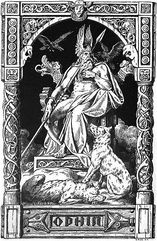 Wikipedia.org
Wikipedia.org Who were the Vikings ?
Prior to the forced conversion to Christianity, the Norse religion had no specific name. Odin,(Old High Germanic Pagan: "Wotan"), whom they called the Allfather or the Father of Gods, was who they believed in and followed. Odin was the ruler of Asgard, the home of the AEsir (all gods). A Viking's highest honour and reward was to die with a sword in his hand and to be carried by the Valkyries to Valhalla, the majestic palace of Odin, where heroic warriors lived in the afterlife.
Archaeology has shown that the history of Vikings and their culture is much more complex than ever before realized. They were very instrumental in opening up the Old World and establishing contacts with other countries and cultures. Their way of life was unique, mystical, and geared to constant developement of the individual and the clan as a whole.
The word 'viking' originally pertained to 'seafaring warriors' or an 'expedition by sea'. It did not designate one race of people -- 'viking' was an activity, not a group of people. To go on a sea journey for whatever reason was referred to as "to go viking".
Since most, if not all, of the raids on Europe, Asia, and North Atlantic Islands by sea were warriors from Denmark, Norway, and Sweden, it was these people that the term viking eventually defined -- they became Vikings in the eyes of the world. Men from the Scandinavian kingdoms were tall and large framed. They were warriors of the toughest kind yet very spiritual.
Prior to the forced conversion to Christianity, the Norse religion had no specific name. Odin,(Old High Germanic Pagan: "Wotan"), whom they called the Allfather or the Father of Gods, was who they believed in and followed. Odin was the ruler of Asgard, the home of the AEsir (all gods). A Viking's highest honour and reward was to die with a sword in his hand and to be carried by the Valkyries to Valhalla, the majestic palace of Odin, where heroic warriors lived in the afterlife.
Archaeology has shown that the history of Vikings and their culture is much more complex than ever before realized. They were very instrumental in opening up the Old World and establishing contacts with other countries and cultures. Their way of life was unique, mystical, and geared to constant developement of the individual and the clan as a whole.
The word 'viking' originally pertained to 'seafaring warriors' or an 'expedition by sea'. It did not designate one race of people -- 'viking' was an activity, not a group of people. To go on a sea journey for whatever reason was referred to as "to go viking".
Since most, if not all, of the raids on Europe, Asia, and North Atlantic Islands by sea were warriors from Denmark, Norway, and Sweden, it was these people that the term viking eventually defined -- they became Vikings in the eyes of the world. Men from the Scandinavian kingdoms were tall and large framed. They were warriors of the toughest kind yet very spiritual.
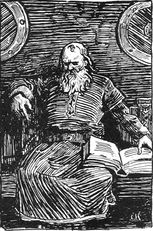 Wikipedia.org
Wikipedia.org Snorrie Sturluson (1179 - 1241), of Iceland, was a historian, mythographer, poet, and politician. The writings of Snorri provide so much information on the Scandinavian kings and people that without them we would have much less knowledge of the Vikings.
So, although the rest of the world saw Vikings as heathens and savages, they were intelligent and cultivated people in their natural daily life.
What drove the Vikings to raids and expansion?
As with most civilizations in ancient times, or even today, there are many reasons for expansion of settlements. Over population, politics, and religious reasons being at the top of the list.
There are many theories as to why the Vikings escalated their raids and expanding settlements. One possible reason is that they could -- they had the time, the training, the desire and the strenth in numbers to make a difference. It was a period when naval operations in western Europe was at a low and there was little organization and even less opposition. England was suffering from political and religious divisions and their defense was not up to par.
Being expert seaman, the Vikings took advantage of the opportunity to expand their world. Their swift longships, their ability to sail at night,and the many towns near navigable rivers, gave the Vikings an advantage.
The reign of Charlemagne (800 - 814) was during the Viking Age. As Charlemagne endeavored to Christianize all peoples, there were de facto entities who rebelled, causing divisions. It was no easy task for Charlemagne to keep all factions of Europe intact and cooperating. During his reign, Charlemagne campaigned hard to convert all pagans to Christianity -- often at the threat of death. Professor Rudolf Simek, Professor of German studies at the University of Bonn, and editor-in-chief of (i)Studia Medievalia Septentrionalia(/i), is of the belief that
"it is not a coincidence if the early Viking activity occurred during the reign of Charlemagne".
The forced conversion to Christianity that Charlemagne fought for created a lot of conflict and division in Norway -- which is a very probable reason why the Vikings fought so hard to sustain their way of life and beliefs.
Trade was of great importance to the Norsemen and when Christian British merchants refused to trade with "heathens and pagans", this put the Vikings in yet another situation which challenged and criticized their honor as trustworthy traders. Hence, increased raids for the supplies they needed.
Vikings were being pushed out of their way of life. Their own homeland of Scandinavia was at a point of over population and more land was needed for settlements. With the serious religious conflicts and divisions in Scandinavian kingdoms, Vikings looked for other places to settle, which often meant raids and conquests to gain more land.
As with most civilizations in ancient times, or even today, there are many reasons for expansion of settlements. Over population, politics, and religious reasons being at the top of the list.
There are many theories as to why the Vikings escalated their raids and expanding settlements. One possible reason is that they could -- they had the time, the training, the desire and the strenth in numbers to make a difference. It was a period when naval operations in western Europe was at a low and there was little organization and even less opposition. England was suffering from political and religious divisions and their defense was not up to par.
Being expert seaman, the Vikings took advantage of the opportunity to expand their world. Their swift longships, their ability to sail at night,and the many towns near navigable rivers, gave the Vikings an advantage.
The reign of Charlemagne (800 - 814) was during the Viking Age. As Charlemagne endeavored to Christianize all peoples, there were de facto entities who rebelled, causing divisions. It was no easy task for Charlemagne to keep all factions of Europe intact and cooperating. During his reign, Charlemagne campaigned hard to convert all pagans to Christianity -- often at the threat of death. Professor Rudolf Simek, Professor of German studies at the University of Bonn, and editor-in-chief of (i)Studia Medievalia Septentrionalia(/i), is of the belief that
"it is not a coincidence if the early Viking activity occurred during the reign of Charlemagne".
The forced conversion to Christianity that Charlemagne fought for created a lot of conflict and division in Norway -- which is a very probable reason why the Vikings fought so hard to sustain their way of life and beliefs.
Trade was of great importance to the Norsemen and when Christian British merchants refused to trade with "heathens and pagans", this put the Vikings in yet another situation which challenged and criticized their honor as trustworthy traders. Hence, increased raids for the supplies they needed.
Vikings were being pushed out of their way of life. Their own homeland of Scandinavia was at a point of over population and more land was needed for settlements. With the serious religious conflicts and divisions in Scandinavian kingdoms, Vikings looked for other places to settle, which often meant raids and conquests to gain more land.
Vikings in Battle
"Battle Fury", or "Battle Frenzy" was a trance-like state of a ferocious and fearless level wherein the warrior affected knew nothing but absolute power, tremendous strength, and a lust for blood-thirsty killing.
In some cases, as in the tales of Cu Chulain, even his own men would give him space during battle and would not come within his sight in order to avoid a quick and merciless death. After the battle was won, it would take several men to tackle and restrain Cu Chulain till the "battle fury" subsided.
Vikings were always ready to battle on their journeys, so were always armed. The very emotional and loud call to Odin from a warrior going into battle is very much dramatized in movies about Vikings -- yet, this is a true account of Vikings, for to call upon their god of gods, Odin, was done when the Viking warriors entered into battle. To hear such a loud call to a god by a large, powerful warrior (in fact many warriors at once) very likely put fear into their enemies.
Odin
When calling upon Odin, a Viking warrior believed he took on the powers of the god, and so became fearless. The average Viking warrior was feirce looking enough due to their size and strength. Then there was the warrior who could transform into a beastile image and state of mind. This was not just in mythology, but real life. It was yet another reason why the Vikings were so feared. Some of their greatest warriors, such as Ivar the boneless, were known to be berserkers.
What is a berserker? ~
Many great Celtic warriors in mythology, such as King Arthur, Ogier the Dane, Cu Chulain and others, would enter into what is called "battle fury" when fighting enemies. Although this attribute of superhuman strength made for good stories in mythology and movies, it is very close to the truth of real Viking warriors. The term "berserker" was given to real life Norse warriors who, when in battle, fought in an uncontrollable, trance-like fury, or frenzy, with no regard to their own safety. In Old Norse literature (the vernacular literature of the Scandinavian peoples up to ca. 1350), berserkers are attested to from numerous sources.
It is believed that the warriors who achieved this state may have taken, or unknowingly been given, a potent herb or some substance that would induce such a state of transformation, such as the halucineogenic Amanita muscaria. This is how many Vikings fought, as if they were in an altered state of consciousness where they felt no fear or pain. Ivar Ragnarsson, referred to as 'Ivar the boneless', was a powerful leader of the Vikings. He was supposedly of great height and strength without any inducements -- in battle he was known to be a berserker and to achieve the level of "battle fury".
King Harald, grandson of Queen Asa of Agder Norway (see 'The Oseberg Ship' below), used groups of berserkers as the first to enter into battle with the enemy. In a ritual unique to them, these warriors would work themselves up into a frenzy, a rage prior to going into battle. Their actual physical appearance would change. Bulging glazed eyes, purple face caused by the blood vessels filling up and bulging on face and neck, a wild and beasty appearance overtaking them -- this was all from the rage boiling within. A band of berserkers could wipe out hundreds of enemy troops in short time because of their altered state of mind. By sending in those warriors first, Harald instilled shock and horror into the enemy, therby weakening their defense lines.
In his 'Ynglinga saga', Snorri Sturluson (1179 - 1241) wrote:
"His (Odin's) men rushed forwards without armour, were as mad as dogs or wolves, bit their shields, and were strong as bears or wild oxen, and killed people at a blow, but neither fire nor iron told upon them. This was called Berserkergang."
Hilda Ellis Davidson (1914 - 2006) was an English aniquarian whose writings focused heavily on paganism, mostly that of the Germanic and Celtic. She is known for contributing immensely to the study of Norse mythology. Davidson wrote profusely on Norse literature, history, and mythology.
A theory that Davidson expounded on was a strong connection to the Viking berserkers and the 'Varangian Guard' of Byzantine emperor Constantine VII (AD 905 - 959). In his "Book of Ceremonies of the Byzantine Court", Constantine VII wrote that the Norse warriors in his service (the Varangia Guard) wore animal skins and masks, which was common to the rituals performed by berserkers. The act of going berserk was known as 'berserkergang'. Odin's special warriors, the Ulfheonar, wore wolf pelts in battle, as stated in the Volsunga saga and the Vatnsdoela saga (Haraldskvaeoi).
In a skaldic poem of the late 9th century, Thorbiorn Hornklofi wrote what is known as the earliest mention of the word "berserker" in a description of King Harald Fairhair's berserkers:
"I'll ask of the berserks, you tasters of blood,
Those intrepid heroes, how are they treated,
Those who wade out into battle?
Wolf-skinned they are called. In battle
They bear bloody shields.
Red with blood are their spears when they come to fight.
They form a closed group.
The prince in his wisdom puts trust in such men
Who hack through enemy shields."
Warriors who survived this state of battle frenzy/fury had gone through such a profound physiological and psychological change that it left them weak and unable to function for days, much like soldiers of today who suffer from PTSD (Post Traumatic Stress Disoder), in which they are very vulnerable to explosive fits of rage.
"Battle Fury", or "Battle Frenzy" was a trance-like state of a ferocious and fearless level wherein the warrior affected knew nothing but absolute power, tremendous strength, and a lust for blood-thirsty killing.
In some cases, as in the tales of Cu Chulain, even his own men would give him space during battle and would not come within his sight in order to avoid a quick and merciless death. After the battle was won, it would take several men to tackle and restrain Cu Chulain till the "battle fury" subsided.
Vikings were always ready to battle on their journeys, so were always armed. The very emotional and loud call to Odin from a warrior going into battle is very much dramatized in movies about Vikings -- yet, this is a true account of Vikings, for to call upon their god of gods, Odin, was done when the Viking warriors entered into battle. To hear such a loud call to a god by a large, powerful warrior (in fact many warriors at once) very likely put fear into their enemies.
Odin
When calling upon Odin, a Viking warrior believed he took on the powers of the god, and so became fearless. The average Viking warrior was feirce looking enough due to their size and strength. Then there was the warrior who could transform into a beastile image and state of mind. This was not just in mythology, but real life. It was yet another reason why the Vikings were so feared. Some of their greatest warriors, such as Ivar the boneless, were known to be berserkers.
What is a berserker? ~
Many great Celtic warriors in mythology, such as King Arthur, Ogier the Dane, Cu Chulain and others, would enter into what is called "battle fury" when fighting enemies. Although this attribute of superhuman strength made for good stories in mythology and movies, it is very close to the truth of real Viking warriors. The term "berserker" was given to real life Norse warriors who, when in battle, fought in an uncontrollable, trance-like fury, or frenzy, with no regard to their own safety. In Old Norse literature (the vernacular literature of the Scandinavian peoples up to ca. 1350), berserkers are attested to from numerous sources.
It is believed that the warriors who achieved this state may have taken, or unknowingly been given, a potent herb or some substance that would induce such a state of transformation, such as the halucineogenic Amanita muscaria. This is how many Vikings fought, as if they were in an altered state of consciousness where they felt no fear or pain. Ivar Ragnarsson, referred to as 'Ivar the boneless', was a powerful leader of the Vikings. He was supposedly of great height and strength without any inducements -- in battle he was known to be a berserker and to achieve the level of "battle fury".
King Harald, grandson of Queen Asa of Agder Norway (see 'The Oseberg Ship' below), used groups of berserkers as the first to enter into battle with the enemy. In a ritual unique to them, these warriors would work themselves up into a frenzy, a rage prior to going into battle. Their actual physical appearance would change. Bulging glazed eyes, purple face caused by the blood vessels filling up and bulging on face and neck, a wild and beasty appearance overtaking them -- this was all from the rage boiling within. A band of berserkers could wipe out hundreds of enemy troops in short time because of their altered state of mind. By sending in those warriors first, Harald instilled shock and horror into the enemy, therby weakening their defense lines.
In his 'Ynglinga saga', Snorri Sturluson (1179 - 1241) wrote:
"His (Odin's) men rushed forwards without armour, were as mad as dogs or wolves, bit their shields, and were strong as bears or wild oxen, and killed people at a blow, but neither fire nor iron told upon them. This was called Berserkergang."
Hilda Ellis Davidson (1914 - 2006) was an English aniquarian whose writings focused heavily on paganism, mostly that of the Germanic and Celtic. She is known for contributing immensely to the study of Norse mythology. Davidson wrote profusely on Norse literature, history, and mythology.
A theory that Davidson expounded on was a strong connection to the Viking berserkers and the 'Varangian Guard' of Byzantine emperor Constantine VII (AD 905 - 959). In his "Book of Ceremonies of the Byzantine Court", Constantine VII wrote that the Norse warriors in his service (the Varangia Guard) wore animal skins and masks, which was common to the rituals performed by berserkers. The act of going berserk was known as 'berserkergang'. Odin's special warriors, the Ulfheonar, wore wolf pelts in battle, as stated in the Volsunga saga and the Vatnsdoela saga (Haraldskvaeoi).
In a skaldic poem of the late 9th century, Thorbiorn Hornklofi wrote what is known as the earliest mention of the word "berserker" in a description of King Harald Fairhair's berserkers:
"I'll ask of the berserks, you tasters of blood,
Those intrepid heroes, how are they treated,
Those who wade out into battle?
Wolf-skinned they are called. In battle
They bear bloody shields.
Red with blood are their spears when they come to fight.
They form a closed group.
The prince in his wisdom puts trust in such men
Who hack through enemy shields."
Warriors who survived this state of battle frenzy/fury had gone through such a profound physiological and psychological change that it left them weak and unable to function for days, much like soldiers of today who suffer from PTSD (Post Traumatic Stress Disoder), in which they are very vulnerable to explosive fits of rage.
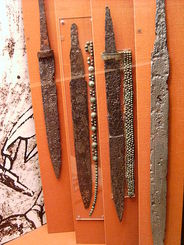 Wikipedia.org
Wikipedia.org Viking Arms and Armor ~
As mentioned earlier in the section "Vikings in battle" above: "Vikings were always ready to battle on their journeys, so were always armed."
Reference to this can be found in the Havamal (Sayings of the high one) of the Poetic Edda. The Poetic Edda is a valuable text of Old Norse poems which is preserved and protected in the manuscript Codex Regius. It is believed that the manuscript was written in the 1270s and was kept in hiding until 1643, when Bishop Brynjolfur Sveinsson of Skalholt (in the south of Iceland, at the river Hvita) somehow gained possession of it. In 1662, the Bishop gifted it to King Frederick III of Denmark, who kept it in Copenhagen until April of 1971. It is now at Reykjavik, the capital and largest city of Iceland, in the Arni Magnuson Institute.
The Codex Regius is so important to Scandinavian literature that when transferred to Reykjavik by ship, it was accompanied by a military escort. The Prose Edda, part of the Codex Regius, was attributed to Saemundr the Learned, a 12th century Icelandic priest. This manuscript and the Poetic Edda by Snorri Sturluson, are the most important extant sources for the mythology and Germanic legends. It has had powerful influence on Scandinavian literature since the early 19th century.
In the Havamal there is sage advice attributed to Odin, the father of gods and the god of warfare in Norse mythology. Regarding weaponry, Odin advises:
""Don't leave your weapons lying about behind your back in a field; you never know when you may need all of sudden your spear."
And in the poem Gestapattr, the first section of the Havamal, Odin give advice to the Norse when traveling and are guests at strange places:
"All the entrances, before you walk forward, you should look at, you should spy out; for you can't know for certain where enemies are sitting, ahead in the hall."
During the Viking Age, all Norse men who were free not only carried weapons at all times, but were required to. The arms each man carried were symbolic of his status in life. The wealthy man would possess a "complete ensemble" of weapons, which included his wooden shield, a spear, a battle axe or sword, and one or two javelins. The men of most wealth would also have a helmet and other armour -- these were probably possessed by only the nobility and their best warriors.
In contrast, a farmer was limited to a spear, shield, and maybe an axe or knife of a good size. Farmers could also use their hunting bows during the beginning of a battle when still at a distance far enough to shoot their arrows.
The common Viking knife was the only weapon that all Vikings, even slaves, would carry. In burial sites, knives are found with not only men, but women and children as well. There were two types of Viking knives.
The Seax is considered a knife, but actually more like a sword or dagger. The tang, aligned with the center of the blade, was inserted into a wood or horn handle. The knife was carried horizontally in its scabbard which was attached to a belt. The edge of the blade was always upwards in the scabbard.
A smaller knife, called a "knifr", was more common. The smallest of these were used for daily utility purposes. The longer knifr was used for hunting and combat.
The Viking longsword was a symbol of high status to the owner, since the swords were very costly to make. They were used in combination with the shield in single-handed combat. They were double edged blades of up to just a little over 35 inches. These swords did not have a pronounced cross-guard. They were not unique to Vikings, for they were used by other cultures throughout Europe.
The axe was very common for Vikings, used as a tool and in combat. Some axes, called Daneaxe, were larger, with the handle and blade length being as tall as the warrior who weilded it with both hands. The shorter handled axes were very sturdy and more common. They could be used up close or thrown by an expert warrior in such a way as to split open a head. Round shields were the most common item for a Viking and used as defense purposes. They were lightweight, of fir, alder, or poplar, and often reinforced with a leather covering and a rim of iron around the edges.
As mentioned earlier in the section "Vikings in battle" above: "Vikings were always ready to battle on their journeys, so were always armed."
Reference to this can be found in the Havamal (Sayings of the high one) of the Poetic Edda. The Poetic Edda is a valuable text of Old Norse poems which is preserved and protected in the manuscript Codex Regius. It is believed that the manuscript was written in the 1270s and was kept in hiding until 1643, when Bishop Brynjolfur Sveinsson of Skalholt (in the south of Iceland, at the river Hvita) somehow gained possession of it. In 1662, the Bishop gifted it to King Frederick III of Denmark, who kept it in Copenhagen until April of 1971. It is now at Reykjavik, the capital and largest city of Iceland, in the Arni Magnuson Institute.
The Codex Regius is so important to Scandinavian literature that when transferred to Reykjavik by ship, it was accompanied by a military escort. The Prose Edda, part of the Codex Regius, was attributed to Saemundr the Learned, a 12th century Icelandic priest. This manuscript and the Poetic Edda by Snorri Sturluson, are the most important extant sources for the mythology and Germanic legends. It has had powerful influence on Scandinavian literature since the early 19th century.
In the Havamal there is sage advice attributed to Odin, the father of gods and the god of warfare in Norse mythology. Regarding weaponry, Odin advises:
""Don't leave your weapons lying about behind your back in a field; you never know when you may need all of sudden your spear."
And in the poem Gestapattr, the first section of the Havamal, Odin give advice to the Norse when traveling and are guests at strange places:
"All the entrances, before you walk forward, you should look at, you should spy out; for you can't know for certain where enemies are sitting, ahead in the hall."
During the Viking Age, all Norse men who were free not only carried weapons at all times, but were required to. The arms each man carried were symbolic of his status in life. The wealthy man would possess a "complete ensemble" of weapons, which included his wooden shield, a spear, a battle axe or sword, and one or two javelins. The men of most wealth would also have a helmet and other armour -- these were probably possessed by only the nobility and their best warriors.
In contrast, a farmer was limited to a spear, shield, and maybe an axe or knife of a good size. Farmers could also use their hunting bows during the beginning of a battle when still at a distance far enough to shoot their arrows.
The common Viking knife was the only weapon that all Vikings, even slaves, would carry. In burial sites, knives are found with not only men, but women and children as well. There were two types of Viking knives.
The Seax is considered a knife, but actually more like a sword or dagger. The tang, aligned with the center of the blade, was inserted into a wood or horn handle. The knife was carried horizontally in its scabbard which was attached to a belt. The edge of the blade was always upwards in the scabbard.
A smaller knife, called a "knifr", was more common. The smallest of these were used for daily utility purposes. The longer knifr was used for hunting and combat.
The Viking longsword was a symbol of high status to the owner, since the swords were very costly to make. They were used in combination with the shield in single-handed combat. They were double edged blades of up to just a little over 35 inches. These swords did not have a pronounced cross-guard. They were not unique to Vikings, for they were used by other cultures throughout Europe.
The axe was very common for Vikings, used as a tool and in combat. Some axes, called Daneaxe, were larger, with the handle and blade length being as tall as the warrior who weilded it with both hands. The shorter handled axes were very sturdy and more common. They could be used up close or thrown by an expert warrior in such a way as to split open a head. Round shields were the most common item for a Viking and used as defense purposes. They were lightweight, of fir, alder, or poplar, and often reinforced with a leather covering and a rim of iron around the edges.
 Wikipedia.org
Wikipedia.org The Oseberg Ship ~
In 834 A.D. a Viking clinker built karv ship was interred in a burial mound in Vestfold , Norway. The ship is almost entirely oak, with elaborate detailed carving on the bow and stern.
Two archaeologists, Haakon Shetelig of Norway and Gabriel Gustafson of Sweden, excavated the mound in 1904 - 1905. Among sever al items of artifacts was an intact cart with four wheels, very decorative and beautifully carved details on it -- the only one from the Viking age that has been found. The manner of the burial, with such fine artifacts indicates a burial of high status of two women, whose skeletons were in the ship. Since no precious metals were found, it was determined that the grave had been robbed not long after the internment.
It is believed that one of the women was of very high rank and the other was sacrificed to accompany her mistress in theafterlife journey. The high ranking woman was possibly Queen Asa who lived in Bygdoy, Norway. Testing on the remains show that the women lived in the same place as Queen Asa did. Queen Asa was the mother of Halfdan the Black and grandmother of Harald Fairhair.
The ship was very well preserved and is on display, along with the artifacts, at the Viking Ship Museum ingdoy of Oslo, Norway. The Oseberg ship is one of the most prized archaeological finds from the Viking era. The craftsmanship on it shows in great detail the master skills of the ship builders.
In 834 A.D. a Viking clinker built karv ship was interred in a burial mound in Vestfold , Norway. The ship is almost entirely oak, with elaborate detailed carving on the bow and stern.
Two archaeologists, Haakon Shetelig of Norway and Gabriel Gustafson of Sweden, excavated the mound in 1904 - 1905. Among sever al items of artifacts was an intact cart with four wheels, very decorative and beautifully carved details on it -- the only one from the Viking age that has been found. The manner of the burial, with such fine artifacts indicates a burial of high status of two women, whose skeletons were in the ship. Since no precious metals were found, it was determined that the grave had been robbed not long after the internment.
It is believed that one of the women was of very high rank and the other was sacrificed to accompany her mistress in theafterlife journey. The high ranking woman was possibly Queen Asa who lived in Bygdoy, Norway. Testing on the remains show that the women lived in the same place as Queen Asa did. Queen Asa was the mother of Halfdan the Black and grandmother of Harald Fairhair.
The ship was very well preserved and is on display, along with the artifacts, at the Viking Ship Museum ingdoy of Oslo, Norway. The Oseberg ship is one of the most prized archaeological finds from the Viking era. The craftsmanship on it shows in great detail the master skills of the ship builders.
Lindisfarne Abbey ~
"AD. 793. This year came dreadful fore-warnings over the land of the Northumbrians, terrifying the people most woefully: these were immense sheets of light rushing through the air, and whirlwinds, and fiery dragons flying across the firmament. These tremendous tokens were soon followed by a great famine: and not long after, on the sixth day before the ides of January in the same year, the harrowing inroads of heathen men made lamentable havoc in the church of God in Holy-island (Lindisfarne), by rapine and slaughter."
- Anglo-Saxon Chronicle
On June 8, 793, England was shocked and devastated when Vikings attacked and destroyed the Lindisfarne Abbey on the Holy Island of Lindisfarne. Alcuin of York, a Northumbrian scholar in Charlemagne's court, wrote:
"Never before has such an atrocity been seen."
For England, this was the beginning of the Viking Age and it was a traumatic experience. For the first time, the courts of Europe were very much aware of the Viking presence. This was the most significant single event that gave the Vikings their bad and feirce reputation as "savage heathens" that lasted for centuries. It was not until the 1890s that the beautiful artistry, advanced technological skills, craftsmanship, and expert seamanhip were recognized and appreciated by scholars and archaeologists outside Scandinavia.
In this author’s opinion, the Vikings were no more or less savage than any other army of warriors who fought in ancient battles. Warriors fight for their homeland, their way of life, and for the right to survive. Vikings have come into their own over the centuries and regained honour and respect for who they were.~ ~ ~
"AD. 793. This year came dreadful fore-warnings over the land of the Northumbrians, terrifying the people most woefully: these were immense sheets of light rushing through the air, and whirlwinds, and fiery dragons flying across the firmament. These tremendous tokens were soon followed by a great famine: and not long after, on the sixth day before the ides of January in the same year, the harrowing inroads of heathen men made lamentable havoc in the church of God in Holy-island (Lindisfarne), by rapine and slaughter."
- Anglo-Saxon Chronicle
On June 8, 793, England was shocked and devastated when Vikings attacked and destroyed the Lindisfarne Abbey on the Holy Island of Lindisfarne. Alcuin of York, a Northumbrian scholar in Charlemagne's court, wrote:
"Never before has such an atrocity been seen."
For England, this was the beginning of the Viking Age and it was a traumatic experience. For the first time, the courts of Europe were very much aware of the Viking presence. This was the most significant single event that gave the Vikings their bad and feirce reputation as "savage heathens" that lasted for centuries. It was not until the 1890s that the beautiful artistry, advanced technological skills, craftsmanship, and expert seamanhip were recognized and appreciated by scholars and archaeologists outside Scandinavia.
In this author’s opinion, the Vikings were no more or less savage than any other army of warriors who fought in ancient battles. Warriors fight for their homeland, their way of life, and for the right to survive. Vikings have come into their own over the centuries and regained honour and respect for who they were.~ ~ ~
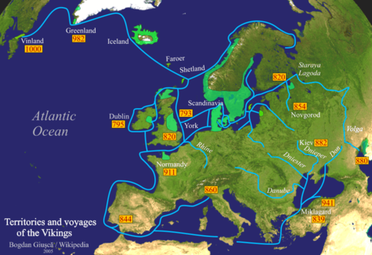
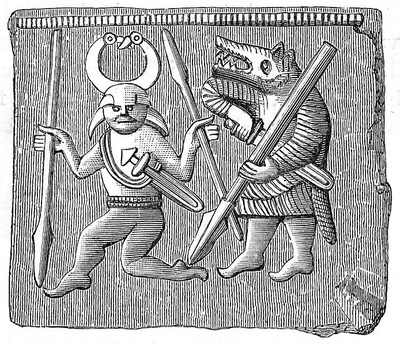
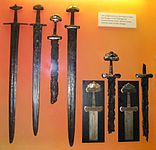
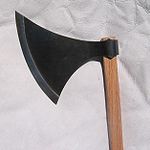

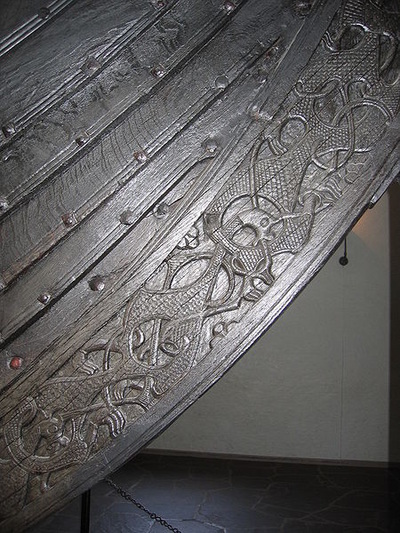
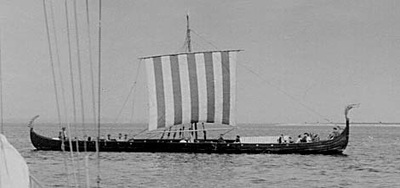
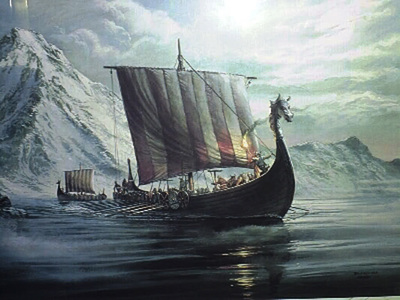
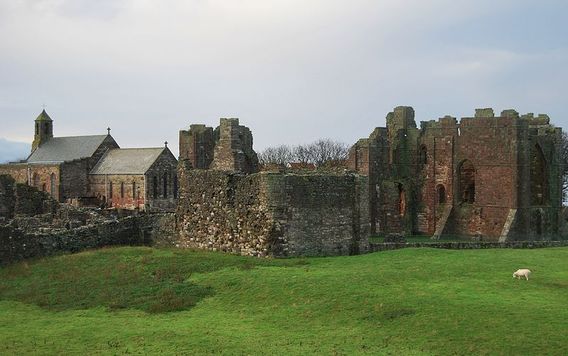
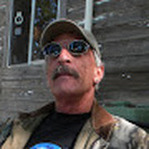
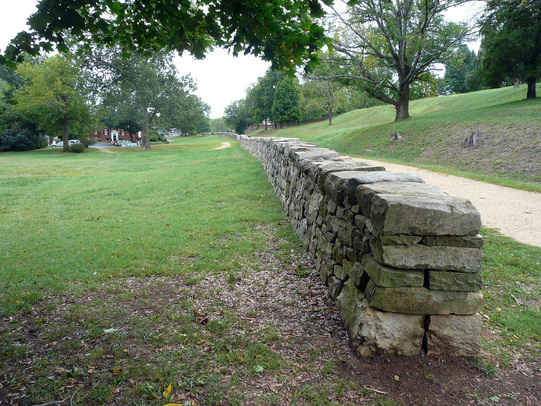
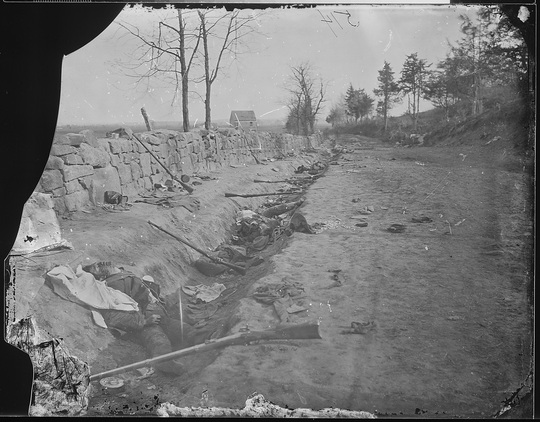
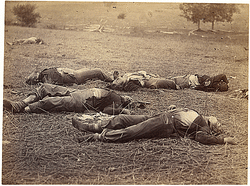
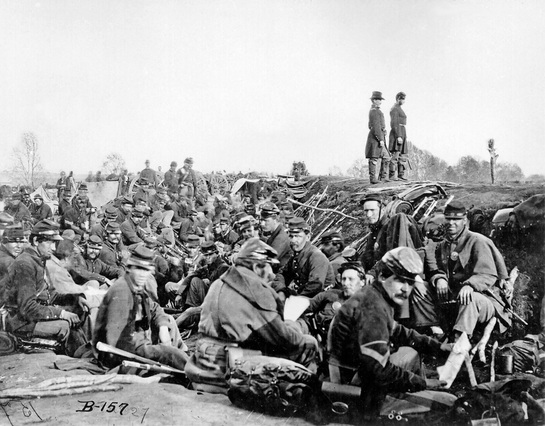
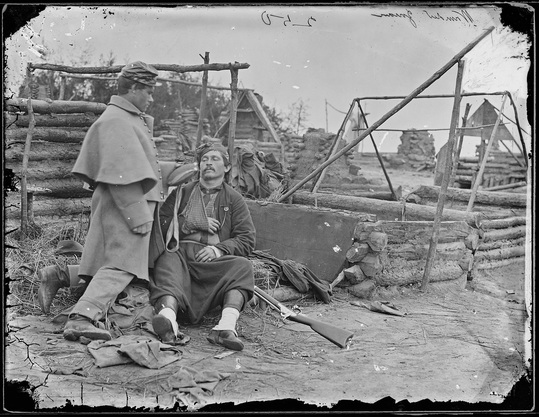
 RSS Feed
RSS Feed
